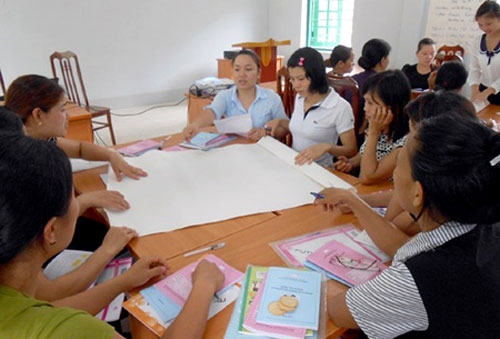
 |
|
Commune health workers participate in a training course on how to use the Handbook for Maternal and Child Health in the northern province of Hoa Binh. — Photo of JICA |
The half-inch thick publication, simply titled Handbook for Maternal and Child Health, turned out to be a life-saver for both Minh and her four-month-old unborn baby.
"One day, I noticed some mucus appearing and read the handbook to see if there was anything wrong." Minh said in a hospital bed in Thanh Hoa Maternity Hospital.
After realising it was a sign of miscarriage, Minh, who is in her mid twenties, did not have time to seek further advice, but rushed to hospital - as the handbook told her to do. The frantic young woman made it in time to save her third child.
Minh's story is one of many positive events that can be credited to the handbook in her hometown in the central province of Thanh Hoa. When another mother from the same province, 28-year-old Hoang Thu Hang, learned that she was pregnant two years ago, she was overjoyed, but deep down she was in turmoil
Hang's first daughter grew up stunted and she wondered if history was going to repeat itself. She blamed herself for not having enough knowledge to raise her daughter properly.
Then she found the handbook and devoured its contents. "When I saw the first line of the book saying ‘To help monitor the health of mother and child', I felt I had found something worthwhile," Hang said. "I did not wander around asking for tips on nurturing anymore. I just followed the book and it was enough."
And she was not wrong. Her 14-month-old second girl is now a big happy child weighing 13 kilograms whereas her sister weighed only 9.5 kilograms at the same age six years ago.
In Hang's commune, the handbook became the talk of the town among mothers endlessly worrying about the 21 per cent malnutrition rate among local children. It challenged many old practices, like letting children eat rice when they were less than a year old or treating diarrhoea by eating guava leaves. For the first time, mothers were able to read in straightforward terms professional information about raising children.
The handbook was a part of a pilot project conducted in Thanh Hoa, Dien Bien and Hoa Binh provinces and the southern province of An Giang. It was produced by the Japan International Co-operation Agency (JICA) in co-operation with the Ministry of Health.
The books have been freely distributed to mothers-to-be and mothers of children under five since 2011. The publication also acts as a health record for themselves and their children. Mothers can be seen reading the handbooks to monitor their pregnancies and the growth of their children to the age of six.
The publication was first introduced in Japan in 1942, where it reduced the mortality rate for children under the age of one from 60.1 per cent to 4.3 per cent today.
"We conducted an assessment of the programme in 2013 and saw a dramatic change in the awareness of mothers of dangerous signs during pregnancy," said Nguyen Minh Tuan, an official of the Ministry of Health's Department of Maternal and Child Heath.
He said the average awareness of pregnant mothers increased three times within three years. An assessment by the ministry also revealed that the use of the handbooks increased the coverage of vaccinations in the four provinces. This is largely due to the inclusion of a vaccination schedule for children at the back of the book.
The average number of children vaccinated against measles, diptheria, whooping cough and tetanus rose twofold from 43.5 per cent in 2011 to 83.4 per cent in 2013.
The handbook can replace four kinds of health records, including maternal health records for mothers, vaccination papers and growth charts for children under five - and a health examination record for both mother and child.
"Putting this all together in one basket is good for containing costs," said the project's chief consultant, Hirotsugu Aiga.
Under the present system in Viet Nam, people have to pay to get their hospital health records if they change towns or are transferred to a different hospital.
"A properly filled out handbook helps doctors keep track of the patients more easily and accurately," said the head of Thanh Hoa Paediatrics Hospital's Internal Medicine and Allergy Department, Nguyen Duy Thai.
"To promote the use of the handbook, we wipe out all other health records in presence and just use the handbook," Minh said.
The Department of Maternal and Child Health and JICA will submit a plan to the Ministry of Health for the national use of the handbook in November.
Consultant Hirotsugu Aiga believes that although it took Japan more than 20 years to fully introduce the handbook, "Viet Nam can implement the handbook much quicker and more efficiently if the political will is strong enough.






- Hanoi launches pilot project to integrate electronic health records into VNeID app
- Empowering new generation of biodiversity champions in Vietnam
- Capital Law to make Hanoi major center for quality education
- Hanoi raises road safety awareness among students
- Hanoi pilots artificial intelligence in five schools
- Modern pediatric hospital opens in Hanoi
